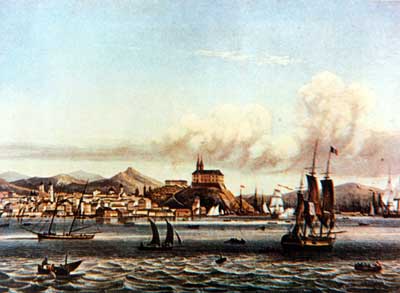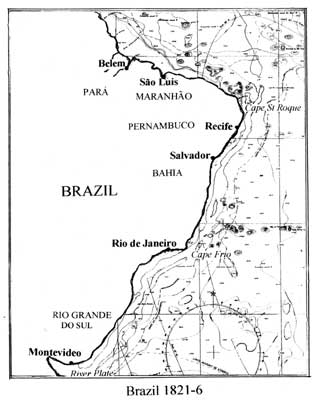|
South
American
Independence
and the Sea
The Napoleonic Wars dealt a devastating blow to the Spanish
Empire in the
Americas.
The arrest of the Spanish Royal Family in 1808 and the French
occupation of Spain produced a maelstrom of revolution and led
to the appointment of local juntas at home and abroad to rule
in the name of the absent king. In the Americas, the juntas
acquired a taste for self-government and, led by radicals and
military strongmen, successively replaced the Royalist
administrations with republican regimes. Argentina was in the
vanguard of this movement. By 1814 it had formed an
independent republic, and in 1818 Argentine troops crossed the
Andes and
liberated
Chile.
Peru was then invaded by sea and, in 1821, became an
independent republic. When Simón Bolívar secured the
territories to the north, in 1825, Spanish South America was
free from Spanish rule.
Territorial armies and land campaigns played a vital role in
securing independence, but command of the sea was also
crucial. While the Spanish Navy ruled the waves it was
impossible to expel the Royalists from the River Plate,
capture the coastal fortresses of
Chile, launch
a successful seaborne attack on
Peru,
or prevent the arrival of reinforcements from
Europe. The creation of local navies by the patriot forces was therefore a
priority.
Fortunately the River Plate provinces,
Chile and
Peru each had access to a naval base – Buenos Aires,
Valparaíso and Callao, the port of Lima. While suitable ships
and equipment were readily available, manpower was more
difficult to come by. In spite of its extensive coastline,
South America was a continent of mines, cattle ranches and
plantations. There was little in the way of maritime tradition
and few people had any knowledge of the sea. The patriot
authorities were faced with the dilemma of finding the sailors
they needed to man and fight their ships.
The solution was partially to be found in
Britain and
Ireland. At the close of the Napoleonic Wars, the Royal Navy
was effectively demobilised. Within a few years, the number of
ships in commission had fallen from 713 to 134 and the number
of men from 140,000 to a mere 23,000. Of the navy’s 5,264
commissioned officers, 90% were unemployed and eking out a
living on half pay, while at the level below there were
legions of former Midshipmen and Masters’ Mates who received
no salary whatsoever. Among these thousands it was not
difficult to find officers and men eager for the pay and prize
money offered by a foreign war.
In 1818, the newly liberated state of
Chile sent a
special recruiting mission to London in search of men and
materials. This proved a successful undertaking, and within
two years, the new Chilean Navy could boast fifty officers and
1,600 men, the majority in each category originating from
Britain
and Ireland.. The commander-in-chief was one of the naval
heroes of the age – a Scottish naval officer, Thomas Lord
Cochrane. Cochrane was a political radical; a military genius
at sea but a quarrelsome nuisance in port. Within two years,
Cochrane and his men had swept the Spanish Navy from the
Pacific and had helped to secure the independence of both
Chile and Peru. Inspired by the Chilean example, when
Argentina
went to war with Brazil in 1825 over control of the northern
bank of the River Plate, the country also toyed with the idea
of recruiting officers and men in London. This proved
unnecessary as, from the beginning, cheap, available land,
high wages and a temperate climate had made the River Plate
ideal for European settlement. The Argentine authorities
found, as they had during the war of independence, that there
were already enough European immigrants with naval experience
to man the new navy it had created under the command of the
Irish-born William Brown.
The Case
of
Brazil
Across the
Andes in Portuguese Brazil, the impact of the Napoleonic Wars
resulted in differing outcomes. In 1807,
the timid and corpulent
Regent of Portugal, Dom João, had avoided capture by Napoleon
by moving his court and government lock, stock and barrel to
the Portuguese colony of
Brazil. Rio de Janeiro became the capital of the Portuguese
Empire and the country boomed as a result. By 1815,
Brazil had been raised to the status of a kingdom – equal to
Portugal in the Braganza dominions. However as a result of the
conclusion of the Napoleonic Wars, King João VI, as he was now
known, had been forced to return to Portugal, leaving his son,
the charismatic 23 year-old Prince Pedro, as Regent. As soon
as the king had returned to
Lisbon,
the Portuguese attempted to turn back the clock and reduce
Brazil to colonial subservience, provoking anger and
widespread resistance throughout the country. A revolt was
masterminded by Brazil’s Chief Minister, a tough 58 year-old
scientist turned politician called José Bonifácio de Andrada e
Silva. It was de Andrada who won the impetuous young Prince
over to the cause and led the country down the path of
independence. On
7 September 1822,
Pedro made his historic declaration of ‘Independence or
Death!’ and a fortnight later, he was crowned Emperor of
Brazil.
The Brazilian revolt was therefore of quite a different nature
from that which had taken place to the southern side of the
Andes.
In Spanish America, the independence movements had been led by republicans
who had swept away the old system and created new institutions
run by new men. In
Brazil,
on the contrary, the independence movement was led by the heir
to the House of Braganza and was monarchical from the
beginning. The machinery of government therefore remained
intact, as did the naval infrastructure, its personnel and its
organisations – the Ministry of Marine, the Navy Board, the
Hospital, Academy, and the Dockyard. The Brazilian government
promptly provided itself with a fighting force by seizing
fourteen warships and fourteen schooners of the Portuguese
Navy deployed in Rio de Janeiro and the River Plate.
Independence had not yet conclusively been achieved in Brazil.
When Pedro made his declaration in 1822, only the central
region around Rio de Janeiro was under Brazilian control; the rest
of the country continued to be dominated by Portuguese juntas
and troops occupying the towns and the coastal capitals. The
most significant of these were Belém, at the mouth of the
Amazon; São Luís do Maranhão on the northern coast; and
Salvador,
capital of the state of
Bahia and the site of a great naval arsenal
and military garrison. Although under siege by a rag-tag
Brazilian army,
Salvador was seen as the springboard for re-conquest and
reinforcements were already en route from Portugal.
In Brazil however, there were two factors in the situation
which had a familiar ring. As in the Pacific, maritime
dominance was crucial. Only by seizing control of the sea
could
Brazil
cut off the flow of reinforcements from Portugal, blockade and
expel the enemy garrisons, and make independence a reality. As
in Spanish America, there was a critical shortage of naval manpower.
Brazil, like Chile and Peru, was a country with no sea-faring
population or maritime tradition. Not only was there a lack of
local recruits to man the ships which comprised the new
Brazilian Navy, but the officers and men who had worked on the
vessels which José Bonifácio’s government had commandeered in
Rio de Janeiro were Portuguese by birth and of doubtful
loyalty.
The Brazilian solution was the familiar one of looking to
Britain and Ireland for the men it needed. The first recruits,
found in Rio de Janeiro, were two young English
Sub-lieutenants, William Eyre and George Manson; and three
senior officers - an American captain called David Jewitt,
Captain Mathias Welch of the Royal Portuguese Navy and
Lieutenant John Taylor of HMS Blossom who, to the fury
of the Admiralty, resigned his commission to become a
Brazilian frigate captain. News had also reached Rio de
Janeiro that Lord Cochrane’s glorious career
in the Pacific had ended in bitter squabbles over pay and
prize money, and that the commander was looking for a job.
Pedro promptly offered him the post of commander-in-chief of
the new Brazilian Navy with the rank of First Admiral.
Cochrane accepted, and arrived in
Rio
in March 1823 accompanied by five officers, all of whom were
commissioned into the Brazilian service
[1] – an Englishman,
John Pascoe Grenfell, a Scot, James Shepherd and two Irishmen
- Cochrane’s flag captain Thomas Sackville Crosbie and
Commander Bartholomew Hayden. The nationality of the fifth
officer, Lieutenant Stephen Clewley, was not recorded.
The major Brazilian recruiting initiative was, however,
carried out in the ports of London and Liverpool in the winter
of 1822-1823. Urged on by Brazil’s agent in the British
capital, General Felisberto Brant, who was receiving alarming
reports of the despatch of Portuguese reinforcements, the
Government authorised a recruiting campaign and the purchase
of huge quantities of arms and naval stores.
[2] On 26
December 1822, Brant appointed a compatriot, Antônio Meirelles
Sobrinho, as Vice‑Consul in
Liverpool,
where he hoped to source the bulk of the men. Meirelles was
told to offer up to £2.60 a month - a figure which compared
favourably with the £1.60 paid to Able Seamen in the Royal
Navy - and was ordered to raise 150 sailors in as expeditious
and clandestine a manner as possible. In London, Brant
employed a former Royal Navy officer, James Thompson, as his
agent. Thompson was appointed as a Brazilian frigate captain
and authorised to find fifty men and five junior officers.
[3]
|



